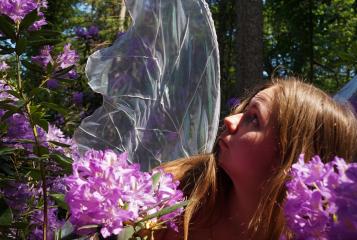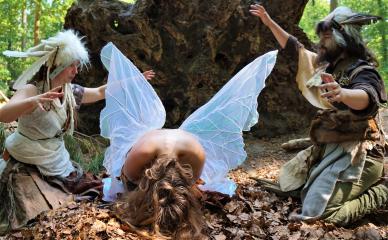General
The Feyfolk are one of the fifteen standard races .
Feyfolk are a race of creatures with no single form. Their original form is tiny and featuring wings, but Feyfolk have the capacity to change their appearance and function after a few years.
The lifespan of a Feyfolk is approximately 100 years.
Physical appearance
The original Feyfolk form looks like a 8cm to about 40cm tall, slender, half-elf half-humans when born. They have white highly transparent wings with a large 16 to 60 cm wide span. Only one in about a thousand Feyfolk never reform and remain this form. This form has, especially in the beginning, a childlike mind because of it's limited brain size.
After reforming a Feyfolk can look like anything but usually has the skin complexity and general shape of the bio-mass that was used during the transformation. This makes most feyfolk have a bark like skin in some places.
Forming and size.
Main article: Feyfolk forms
Feyfolk usually don't stay the same shape their entire life. After about 4 to 12 years of living in one form the feyfolk has fully grown and can make a choice to change and become another form. After their choice, the change happens. Other feyfolk can help this process along. The process takes a few weeks, months or even years, depending on the nature of the change. Most of the changes require a form of cocoon to be in during the change. This process is very straining on the feyfolk's body, and usually takes years away from its life expectancy. After changing shape, a feyfolk should wait until they are fully grown once more, otherwise the process may deem lethal. The process also consumes a lot of energy and renders the Feyfolk involved unable to do anything else for the duration. Small changes, sometimes only cosmetic, are also possible and less straining on the body. This still takes up energy and cannot be done often.
Feyfolk are only 8cm to about 40cm tall in their original form. Feyfolk however have the capacity to melt together with various death organism, and bio-waste to add mass during their forming, they also consume allot of food during this process. Feyfolk can even melt together with other feyfolk to create one larger organism, the personalities merge and are lost in the process, and a split can never again happen.
Shrinking down to a new size is relatively easier on the body, since it only has to get rid of excess mass. Large feyfolk that choose to do this can house their experiences, knowledge and higher brain functions in a temporary external cocoon for later retrieval. This external cocoon needs to be fed from time to time in order for it to remain alive.
Reproduction
The average female feyfolk can produce around twenty offspring in her lifetime, in litters of up to five. This may seem high, but mortality rates of young feyfolk are quite high due to their childlike nature (keeping track of them often proves an impossible task for the parents), their small size, their low brain capacity and the fact that they're easy prey.
Feyfolk tend to be born in their original shape but if both parents or sometimes even if only the mother is a different form, the feyfolk can also be born in that form, or in a different form altogether. This all depends on the biological makeup of the mother.
A lot of feyfolk forms don't have reproductive organs, but feyfolk do have the capacity to grow genitals regardless. Having genitals, and other reproductive organs is a conscious choice. Several ways of actual reproduction are possible depending on the form but the simple choice for feyfolk that want children is to choose a form with a standard cloaca and a system in which they have several eggs. Other possibilities include having an actual penis to inject the DNA material deep within the body of the recipient or completely different systems altogether, for example a system where the two feyfolk merge into a single being to share their DNA before extruding embryo's from the skin.
Diet
Feyfolk are biologically herbivores.
Most feyfolk forms have a digestive system geared towards the local flora and might have trouble when relocating quickly.

